I followed a tutorial that one of the Mums linked me to, you can see it here. I wanted to show you a start to finish version as I do some things different to the methods described there.
First I skein the yarn, which is pretty much just putting it over the back of a kitchen chair and wrapping it around. Or I put it over my knees and wrap it. This is best performed when the wee one (TWO) is not around as she likes to 'help'.
It usually ends up looking something like this :
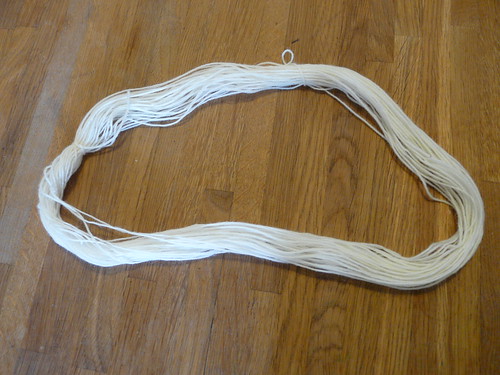
Then I tie it in different places, making sure that I weave the ties in between the strips of yarn. I generally try and use something that is of a different colour to make sure I can find it again after I've finished.

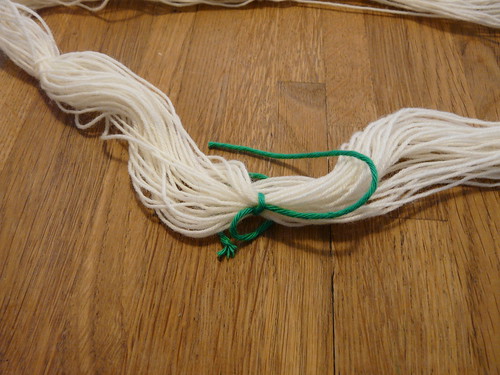
Then it is soaking time. As per the tutorial, warm/hot water with vinegar in it. I have some crazy strong Swedish vinegar, 24% acetic acid. Normal stuff is about 6% so I add just a little to my warm/hot water and it seems to work. For more specific volumes, see the tutorial there. 30 mins at a minimum, but I often leave if for a long time because I get distracted easily.

There you can see my white yarn having a wee soak.
Once it's nice and soaked, I add it to my dye pot. I add some of the dye to a big pot of water on the stove, with another splash of vinegar for good measure. You need enough water to cover the yarn.
Here is my colour choice, lemon yellow for some bright as all get out socks for the cold and dark Swedish winter.

Lower the yarn in and poke it to get it to be submerged, but no stirring or swirling, that way felting lies.
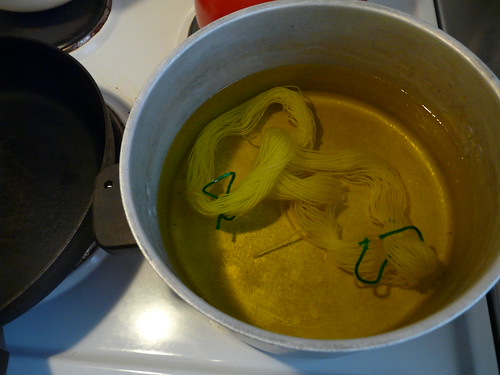
Here is one place I vary from the tutorial given on the link, I will sometimes just let the yarn sit in the pot overnight without heating. It does work, it just takes time. If you don't have forever and a day, put the stove on a low heat and remember, boiling equals felting, so warm but not boiling is the plan.
I check the yarn every so often, say 15 mins or so, until one of two things happens. 1. All the dye is gone from the water or 2. They yarn looks a little bit darker than I want it to end up.
Then if you have just be leaving it in the pot without heat, time to rinse and enjoy your newly dyed yarn. Or if you have heated it, let it cool down in the pot and then rinse.
Here is my rinsed yellow yarn
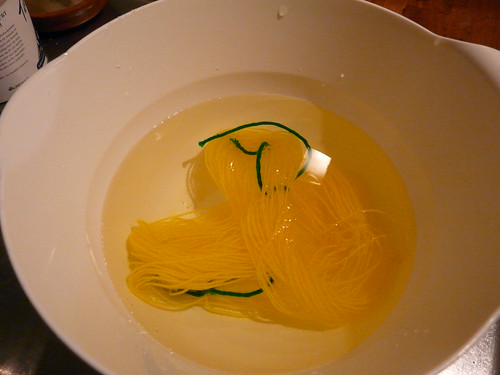
I took this yellow yarn, with its variegated colour and knitted myself a pair of short yellow socks. Unfortunately, as seems almost always the case for me, I ran out just before I finished the second sock. So I had to dye some more yarn. It ended up slightly less variegated than the first. Here are my newly knitted YELLOW socks. Ready to keep my cold feet warm this autumn and winter. And not a moment too soon, it was frosty this morning. They would also do well should I encounter a Gox that needs boxing. We have been reading a lot of Dr Seuss of late and every time I see the page about yellow Gox box socks, I think of these beauties.

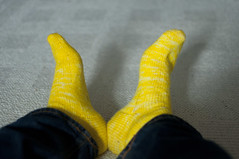
And that is my story of how I dye yarn. I've done quite a bit, and I intend on sharing the other exploits here soon. But for now, I have to head off and wash said yellow socks along with a banana encrusted jumper that TWO needs in this less that warm weather. Raveled here.

1 comment:
Fabulous!!
Post a Comment